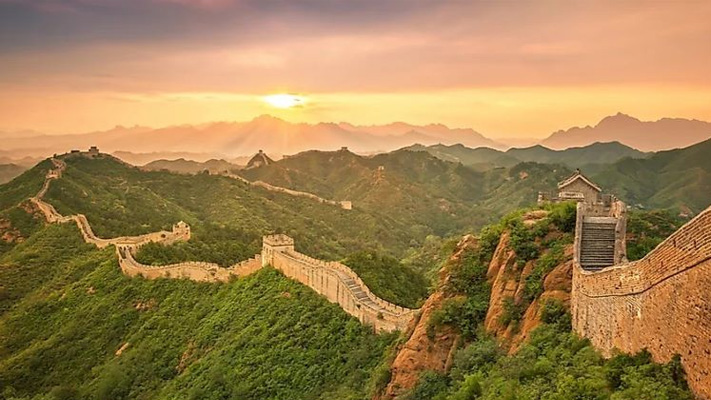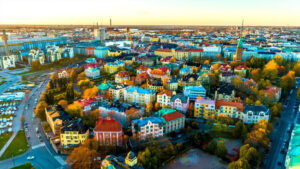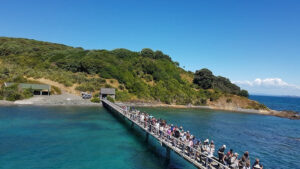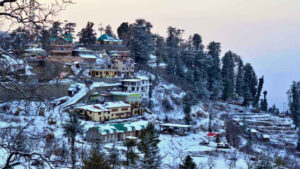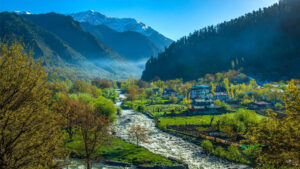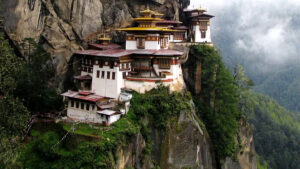THE GREAT WALL OF CHINA – STEP INTO HISTORY, STAND ON GREATNESS

The Great Wall of China is one of the most iconic and remarkable architectural wonders in the world. It stands tall as a testament to human ingenuity and perseverance. Spanning thousands of kilometres, this awe-inspiring architectural wonder has captivated travellers from around the world. With its rich history, cultural significance, and breathtaking vistas, the Great Wall offers a once-in-a-lifetime experience for visitors seeking to unravel the mysteries of ancient China.

The Great Wall of China stretches across approximately 21,196 kilometers (13,171 miles) from the east coast to the west of China. It traverses several provinces, including Liaoning, Hebei, Beijing, Tianjin, Shanxi, Inner Mongolia, Shaanxi, Ningxia, Gansu, and Qinghai.
The wall is made of various materials, including stone, brick, wood, and earth. It features watchtowers, battlements, beacon towers, and fortified passes. The design and structure of the wall vary in different sections, depending on the geography and building techniques of the respective time periods.
Significance and Cultural Importance
Beyond its defensive purpose, the Great Wall holds deep cultural significance for the Chinese people. It symbolizes unity, resilience, and the indomitable spirit of a nation. Immerse yourself in the stories, legends, and folklore associated with this majestic structure, and gain insight into its profound impact on Chinese art, literature, and identity.
Sections of the Great Wall
The Great Wall of China is comprised of several sections, each offering a unique experience and showcasing different aspects of this remarkable structure. Here are some notable sections of the Great Wall that visitors can explore:
1. Badaling: Located near Beijing, Badaling is one of the most famous and well-preserved sections of the Great Wall. It attracts a large number of tourists due to its accessibility and proximity to the capital city. The walls here are majestic and fully restored, offering panoramic views of the surrounding mountains and valleys.
2. Mutianyu: Situated approximately 70 kilometers northeast of Beijing, Mutianyu is another popular section known for its natural beauty and well-preserved fortifications. It features a mix of restored and original sections, providing visitors with an authentic experience. Mutianyu also offers a cable car ride and a thrilling toboggan descent, adding to the adventure.
3. Jinshanling: For those seeking a more rugged and authentic experience, Jinshanling is an ideal choice. Located in Hebei Province, this section boasts a diverse range of architectural styles, including watchtowers, beacon towers, and fortresses. It offers stunning panoramic views of the surrounding landscapes and provides opportunities for long hikes along its less crowded trails.
4. Simatai: Adjacent to Jinshanling, Simatai is another section that offers a mix of restored and original structures. Known for its steep slopes and challenging terrain, Simatai provides a thrilling experience for adventurous hikers. Its unique features include the “Sky Bridge,” a suspended walkway offering breathtaking views, and the opportunity to witness the wall illuminated during night tours.
5. Huanghuacheng: Located in Beijing’s Huairou District, Huanghuacheng offers a picturesque setting with its stunning combination of the Great Wall, mountains, and a reservoir. This section features a mix of restored and unrestored walls, allowing visitors to witness the original construction techniques and experience a less crowded environment. It also offers the chance to hike and enjoy water-based activities in the reservoir.
6. Jiankou: Renowned for its rugged beauty and wild appearance, Jiankou is a challenging section suitable for experienced hikers and adventurers. Located in Huairou District, this section remains mostly unrestored, showcasing the original structure of the Great Wall. It offers breathtaking vistas and the opportunity to witness the magnificent landscape in its raw form.

7. Gubeikou: Gubeikou, situated in Miyun County, Beijing, is a less crowded section known for its historical significance and natural beauty. It features well-preserved walls that have witnessed centuries of history. Gubeikou offers a peaceful and serene environment, perfect for those seeking a tranquil experience and opportunities for scenic hikes.
Visitor Experience and Activities
When visiting the Great Wall of China, visitors can expect a range of experiences and activities that make their trip memorable. Here are some key aspects of the visitor experience and activities available:
1. Hiking: One of the most popular activities on the Great Wall is hiking. The wall’s diverse sections offer varying levels of difficulty, catering to both leisurely strolls and challenging treks. Visitors can embark on hikes along restored paths or opt for more adventurous routes that traverse wild and unrestored sections. Hiking allows you to immerse yourself in the awe-inspiring landscapes and experience the grandeur of this architectural wonder up close.
2. Panoramic Views and Photography: The Great Wall offers breathtaking panoramic views of the surrounding countryside, mountains, and valleys. Visitors can capture stunning photographs at various vantage points along the wall, capturing the beauty of the landscape and the impressive architecture. Sunrise and sunset moments are particularly captivating, casting a golden glow on the ancient stone structures.
3. Cultural Interactions: Engaging with the local culture is an enriching part of the Great Wall experience. Visitors can interact with friendly villagers who live near the wall, gaining insights into their way of life and traditions. Local vendors often sell handicrafts and souvenirs, providing opportunities to support the local economy and take home unique mementos.
4. Cable Car Rides and Toboggan Descents: Certain sections of the Great Wall offer cable car rides, providing a convenient and scenic way to reach the higher sections. Cable cars offer panoramic views during the ascent, allowing visitors to appreciate the vastness of the wall and the surrounding landscapes. Additionally, some sections, such as Mutianyu, offer a thrilling toboggan ride for a fun and adventurous descent from the wall.
5. Camping and Overnight Stays: For a truly immersive experience, some sections of the Great Wall allow visitors to camp overnight. Spending a night under the stars on the wall offers a unique opportunity to connect with the historical atmosphere and appreciate the tranquility of the surroundings. Some tour operators provide camping equipment and organize guided camping experiences.
Cultural and Festive Events
The Great Wall of China serves as a backdrop for various cultural and festive events that celebrate the rich heritage and historical significance of this iconic landmark. Here are some notable events and festivals that take place at or near the Great Wall:

- Great Wall Marathon: The Great Wall Marathon is a world-renowned event that combines athletic prowess with a scenic and challenging course along the Great Wall. Participants from around the globe gather to run a marathon, half-marathon, or shorter distances, taking in the breathtaking views and experiencing the physical and mental demands of this unique race.
- Lantern Festivals: During traditional Chinese Lantern Festivals, which typically take place in late winter or early spring, the Great Wall and its surrounding areas are adorned with vibrant lanterns. These festivals feature cultural performances, lantern displays, and traditional games, providing visitors with a captivating and festive atmosphere.
- International Music Festivals: The Great Wall has become a sought-after venue for international music festivals, attracting renowned artists from different genres. Music enthusiasts can enjoy live performances against the backdrop of the ancient wall, creating an unforgettable fusion of music and history.
- Spring and Autumn Equinox Celebrations: During the spring and autumn equinoxes, special ceremonies and celebrations are held at certain sections of the Great Wall. These events mark the balance between day and night and the change of seasons. Visitors can witness traditional rituals, performances, and cultural activities that reflect the ancient Chinese belief in harmony and balance.
- Cultural Performances: Throughout the year, cultural performances take place at various locations near the Great Wall. Traditional music concerts, dance performances, acrobatics, and martial arts demonstrations showcase the rich cultural heritage of China. Visitors can witness the artistry and skill of performers, gaining a deeper appreciation for Chinese traditions.
Practical Information
When planning a visit to the Great Wall of China, it’s important to consider some practical information to ensure a smooth and enjoyable experience. Here are some practical tips and information to help you plan your trip:
- Best Time to Visit: The Great Wall can be visited year-round, but the best time to go is during spring (April to May) and autumn (September to October). These seasons offer pleasant weather, with mild temperatures and clear skies, providing optimal conditions for exploring and enjoying the views. It’s advisable to avoid visiting during national holidays, such as the Chinese New Year holiday (late January to early February), as crowds can be overwhelming.
- Selecting a Section: The Great Wall is vast, and there are several sections to choose from. Consider your preferences, fitness level, and desired experience when selecting a section to visit. Popular and well-preserved sections like Badaling and Mutianyu are easily accessible, while wild and challenging sections like Jiankou and Jinshanling offer a more adventurous experience. Research and gather information about each section to make an informed decision.
- Transportation: The Great Wall is located in different provinces, so transportation options vary depending on the section you choose. For sections near Beijing, such as Badaling and Mutianyu, public buses, private tours, and taxi services are available. Some sections may require a combination of transportation modes, such as a bus followed by a short hike or cable car ride. Plan your transportation in advance and consider the most convenient option for your chosen section.

- Facilities and Amenities: Sections like Badaling and Mutianyu have well-developed facilities, including restrooms, restaurants, souvenir shops, and information centers. However, facilities may be more limited or non-existent in wilder sections. If you have specific requirements or need certain amenities, it’s recommended to choose a section that provides the necessary facilities or plan accordingly.


